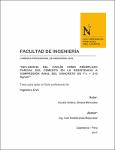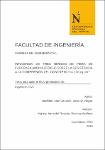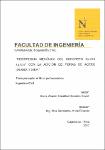Mostrar el registro sencillo del ítem
Influencia del caolín como reemplazo parcial del cemento en la resistencia a compresión axial del concreto de f’c = 210 kg/cm2
| dc.contributor.advisor | Mejía Díaz, Iván Hedilbrando | |
| dc.contributor.author | Acosta Solano, Eleana Mercedes | |
| dc.date.accessioned | 2018-07-02T20:43:58Z | |
| dc.date.available | 2018-07-02T20:43:58Z | |
| dc.date.issued | 2018-06-21 | |
| dc.identifier.citation | Acosta, E. M. (2017). Influencia del caolín como reemplazo parcial del cemento en la resistencia a compresión axial del concreto de f’c = 210 kg/cm2 (Tesis de licenciatura). Repositorio de la Universidad Privada del Norte. Recuperado de http://hdl.handle.net/11537/13481 | es_PE |
| dc.identifier.other | TES 624 ACOS 2017 | es_PE |
| dc.identifier.uri | https://hdl.handle.net/11537/13481 | |
| dc.description.abstract | RESUMEN El Caolín es una arcilla, la cual al ser sometida a altas temperaturas tiende a mostrar sus propiedades puzolánicas. En esta investigación, se presenta la INFLUENCIA DEL CAOLÍN COMO REEMPLAZO PARCIAL DEL CEMENTO EN LA RESISTENCIA A COMPRESIÓN AXIAL DEL CONCRETO DE F´c = 210 Kg/cm2, teniendo como objetivo principal: Determinar la influencia del caolín como reemplazo parcial del cemento en la resistencia a compresión axial del concreto de f’c = 210 Kg/cm2. El Caolín se extrajo de la cantera de Llacanora, para luego ser sometido a un horno a elevadas temperaturas, seguido de una trituración para la obtención de ceniza de Caolín, evidenciándose a través del ensayo químico de la muestra de caolín realizado que este cumplió con las características para ser utilizado como material puzolánico. La metodología consistió en realizar probetas de concreto con f’c de diseño de 210 kg/cm2, reemplazando diferentes porcentajes (5%, 10% y 15%) de cemento por ceniza de caolín y probetas patrón (sin incorporación de Caolín), se realizaron los ensayos al concreto en estado fresco y endurecido, siendo el más importante el concreto en estado endurecido (ASTM C 39). Finalmente se evaluó la resistencia a compresión axial del concreto a los 7, 14 y 28 días, después del curado respectivo. En base a los resultados obtenidos al incorporar los diferentes porcentajes de caolín (5%, 10% y 15%), se pudo observar que al realizar el ensayo a compresión a los 7 días, la resistencia disminuye en 5.53%, 11.01% y 25.95% respectivamente con respecto a la muestra sin incorporación y en el ensayo realizado a los a los 14 y 28 días, la resistencia aumenta a los 14 días en 8.84%, 25.76% y 36.97% respectivamente y a los 28 días en 31.91%, 75.71% y 86.88% respectivamente, con respecto a la muestra sin incorporación, con esto se puede afirmar que la hipótesis planteada si cumple. | es_PE |
| dc.description.abstract | ABSTRACT Kaolin is a clay, which when subjected to high temperatures tends to show its pozzolanic properties. In this research, we present the CABLIN INFLUENCE AS PARTIAL REPLACEMENT OF CEMENT IN THE RESISTANCE TO AXIAL COMPRESSION OF THE CONCRETE OF F'c = 210 Kg/cm2, having as main objective: To determine the influence of kaolin as a partial replacement of cement in the resistance to axial compression of the concrete of f'c = 210 Kg/cm2. The kaolin was extracted from the quarry of Llacanora, and then subjected to a furnace at high temperatures, followed by a crushing to obtain Kaolin ash, evidenced by the chemical test of the kaolin sample made that it complied with the characteristics to be used as pozzolanic material. The methodology consisted of making concrete specimens with design f'c = 210 kg/cm2, replacing different percentages (5%, 10% and 15%) of cement by kaolin ash and standard specimens (without incorporation of kaolin). they carried out tests on concrete in a fresh and hardened state, the most important being concrete in the hardened state (ASTM C 39). Finally, the resistance to axial compression of the concrete was evaluated at 7, 14 and 28 days after the respective curing. Based on the results obtained by incorporating the different percentages of kaolin (5%, 10% and 15%), it was observed that when performing the compression test at 7 days, the resistance decreases by 5.53%, 11.01% and 25.95 % respectively with respect to the sample without incorporation and in the test conducted at 14 and 28 days, the resistance increases at 14 days at 8.84%, 25.76% and 36.97% respectively and at 28 days at 31.91%, 75.71% and 86.88% respectively, with respect to the sample without incorporation, with this it is possible to be affirmed that the hypothesis raised if it is fulfilled. | es_PE |
| dc.description.uri | Tesis | es_PE |
| dc.format | application/pdf | es_PE |
| dc.language.iso | spa | es_PE |
| dc.publisher | Universidad Privada del Norte | es_PE |
| dc.rights | info:eu-repo/semantics/openAccess | es_PE |
| dc.source | Universidad Privada del Norte | es_PE |
| dc.source | Repositorio Institucional - UPN | es_PE |
| dc.subject | Resistencia a la comprensión | es_PE |
| dc.subject | Cemento | es_PE |
| dc.subject | Agua | es_PE |
| dc.title | Influencia del caolín como reemplazo parcial del cemento en la resistencia a compresión axial del concreto de f’c = 210 kg/cm2 | es_PE |
| dc.type | info:eu-repo/semantics/bachelorThesis | es_PE |
| thesis.degree.grantor | Universidad Privada del Norte. Facultad de Ingeniería | es_PE |
| thesis.degree.level | Título Profesional | es_PE |
| thesis.degree.discipline | Ingeniería Civil | es_PE |
| thesis.degree.name | Ingeniero Civil | es_PE |
| dc.publisher.country | PE | es_PE |
| dc.subject.ocde | https://purl.org/pe-repo/ocde/ford#2.01.01 | es_PE |
| thesis.degree.program | Pregrado | es_PE |
| dc.description.sede | Cajamarca | es_PE |
| renati.discipline | 732016 | es_PE |
| renati.level | https://purl.org/pe-repo/renati/level#tituloProfesional | es_PE |
| renati.type | https://purl.org/pe-repo/renati/type#tesis | es_PE |
Ficheros en el ítem
Este ítem aparece en la(s) siguiente(s) colección(ones)
-
Tesis [1437]





